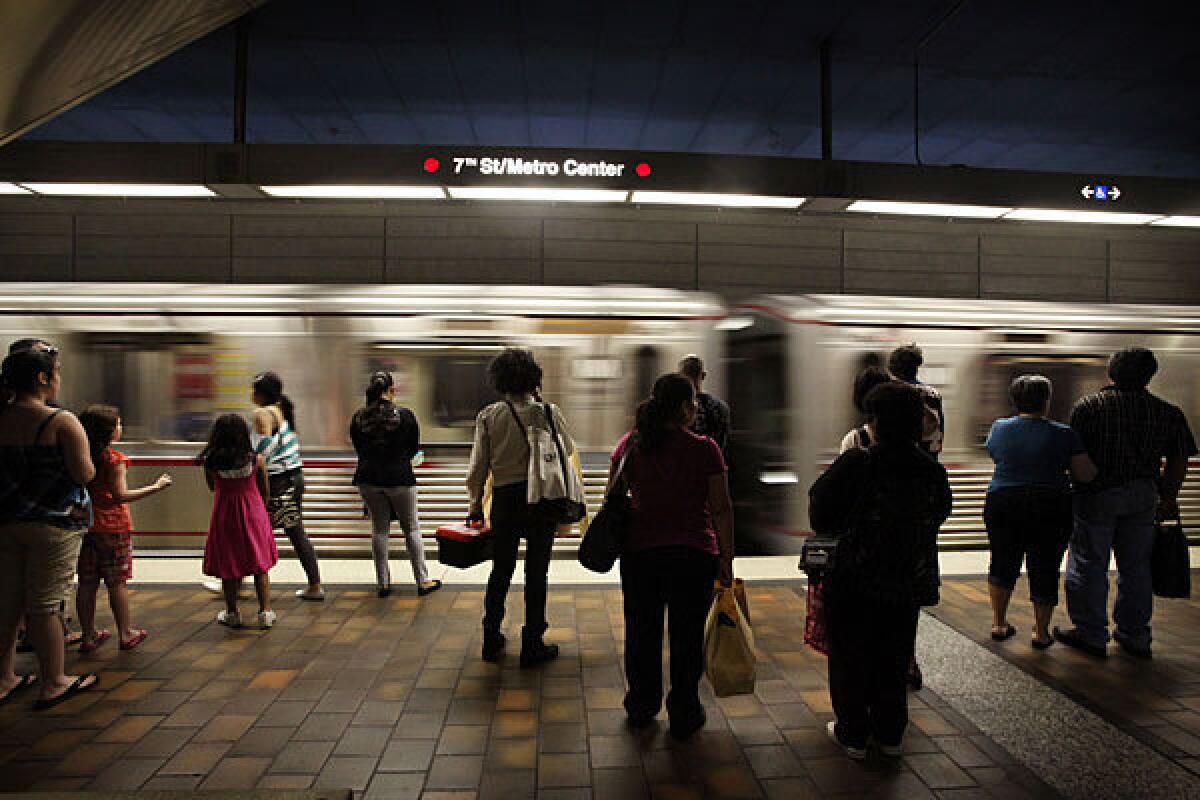Transportation advocates back half-cent sales tax hike

- Share via
Hoping to garner voter and political support across Los Angeles County for a possible half-cent sales tax increase, transportation advocates gathered downtown Friday to unveil a proposal for a 2016 ballot measure that could fund a range of new transit projects, including a toll highway and rail line through the Sepulveda Pass.
The tax proposal, announced by the advocacy group Move L.A., could raise an estimated $90 billion over 45 years and cost the average resident 25 cents to 30 cents a day, proponents said. It would also boost the countywide sales tax to 91/2 cents on each $1 spent — though shoppers in cities with their own sales tax would pay higher rates.
Responding to critics who complained that the city of Los Angeles received the lion’s share of transit projects from the half-cent sales tax increase approved by voters six years ago, elected officials — including Los Angeles Mayor Eric Garcetti — emphasized that revenue from the new tax proposal would benefit all areas of the county.
“It will not simply be Mother Metro saying, ‘This is what you get,’ ” Metro Board of Directors Chairwoman Diane DuBois, a councilwoman from Lakewood, told conference attendees.
Metro has not yet decided to put a measure on the ballot. But with as much as $27 billion in added tax money to spend on rail projects, advocates said, the agency could build a light-rail link to Burbank’s Bob Hope Airport, convert the San Fernando Valley Orange Line busway to rail and extend the Green Line near LAX to sweep through South Bay cities and connect with the Blue Line in Long Beach.
“What we’re doing here is trying to figure out what wins,” Move L.A. Executive Director Denny Zane said.
The tax increase would need a super-majority of 67% to pass. Metro’s preliminary polling says that 58% of residents would support a tax increase.
Any tax increase that goes on the ballot must appeal to voters in Beverly Hills, the San Gabriel Valley and South Los Angeles, county Supervisor Mark Ridley-Thomas said. The proposal “has to be regional, it has to be rational, it has to equitable — all three, all the time, all day long,” he told conference attendees. “If we neglect any one of those three elements, it will put the very proposition at risk.”
Guaranteeing projects across the county may be a political necessity, but it doesn’t always serve passengers the best, said Lisa Schweitzer, a USC professor who studies transit funding. She said transit-using communities with the potential for highest ridership, a common measure of success, tend to be clustered in the core of the county.
Two years ago, a proposed extension of the county transit sales tax approved in 2008 fell 0.6% shy of garnering the required two-thirds supermajority of votes. The loss came as a result of weak support in suburban, relatively well-off communities of the South Bay and the Westside, a Times analysis found. The analysis found support for the sales tax had eroded significantly from four years earlier, when voters initially approved the half-cent sales tax increase for transit.
“In order to get those areas interested in transit, you have to gold-plate it and sugarcoat it” with high-profile projects such as the Westside subway extension, which appeal to residents who typically drive their own cars, Schweitzer said. “But you can’t win without them.”
Twitter: @laura_nelson
Times staff writer David Zahniser contributed to this report.
More to Read
Sign up for Essential California
The most important California stories and recommendations in your inbox every morning.
You may occasionally receive promotional content from the Los Angeles Times.











